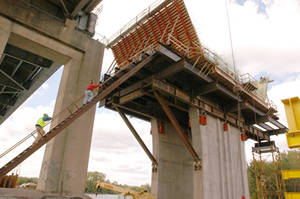 |
Steel shell pilings await placement for use on the west end of the
I-494 river bridge that will carry westbound traffic. Photo by Dave
Gonzalez
|
In Mn/DOT’s verbal shorthand, people call the project the new Wakota bridge.
It is, however, a lot more than ‘just a new bridge.’
The $250 million project actually includes a total of 28 bridges, rebuilding
sections of I-494 and Hwy 61 in St. Paul and its suburbs as well as ramps and
loops connecting a web of local roads.
Included in the project are two new bridge spans across the Mississippi River
that will replace the existing single, four-lane span. The new river bridges
will be built in stages. Both will have five lanes to carry the rapidly increasing
traffic flow from Washington and Dakota counties into St. Paul, Minneapolis
and the suburban cities west of the river.
Work on the overall project started in 2002; the construction will be completed
in 2007.
Cities located in the project area are St. Paul, South St. Paul, Newport, St.
Paul Park, Maplewood and Cottage Grove.
The Wakota project will upgrade Hwy 61 to freeway status from St. Paul Park
to Carver Avenue in St. Paul, improve local roads and create pedestrian and
bicycle trails along several routes. Interstate 494 will be rebuilt between
Concord Street in South St. Paul and Lake Road in Woodbury. In addition, several
interchanges on I-494 and Hwy 61 will be rebuilt, eliminating traffic lights
and improving the flow of traffic.
Funds for the project come from monies set aside for bottleneck removal in
the Twin Cities metro area by the Legislature and from matching federal grants.
 |
Workers assemble concrete forms for the pier table on
top of the pier on the east bank of the Mississippi River. Photo by Dave
Gonzalez
|
When completed, the Wakota project will reduce severe commuter congestion in
the area and increase safety and traffic capacity in the southeastern quadrant
of the Twin Cities metro area.
Both new concrete spans over the river will be built in segments starting with
a center pier and extending the bridge outward in a balanced cantilever method.
Work on the bridge that will carry eastbound traffic is under way; construction
of the westbound bridge will begin in 2005 following completion of the new bridge
and removal of the old four-lane structure.
Facing unique hurdles
Adam Josephson, project manager, Metro District, said the project faces some
unique hurdles before its eventual completion.
For example, he said, a glacial trench filled with clay underlies part of the
project. In order to obtain sufficient soil strength, engineers mixed cement
with existing soil underground by using a huge auger system. The slurry hardened
into a mixture that provides enough strength to support a bridge and retaining
wall that are part of the Glen Road interchange.
Building the project in the corridor near the Mississippi River also requires
moving several high-pressure natural gas lines and electrical transmission lines.
Project managers also had to negotiate with three railroads to work near the
mainline tracks. A construction staging area for barges and other equipment
was created under the new Wakota bridges.
"The scope of the project," he said, "is a challenge."
 |
Ironworkers prepare epoxy-coated reinforcing steel to use in the bridge.
Epoxy-coated rebar inhibits corrosion and extends the bridge’s life
span. Photo by Dave Gonzalez
|
All of the work on the project is being done under traffic. To improve safety
and keep traffic moving, Mn/DOT has contracted with a towing company to remove
stalled cars in the project area quickly.
Project staff meet regularly with business owners and officials from the cities
in the project area on maintaining access to businesses and other issues. The
project even has its own public access cable TV show. In addition, the Southern
Washington County Bulletin carries frequent articles about the project’s
progress. The Metro District maintains a project
Web site and issues newsletters each spring. A model of the project is currently
on display at Newport City Hall.
Mary McFarland, project public affairs coordinator, Metro District, said the
extensive outreach efforts are needed to maintain support for the project throughout
its six-year construction period.
"Wakota is second in scope only to the I-394 project in the Twin Cities
area and it’s being done under traffic," she said. "We need to communicate
about the project in as many ways as we can to avoid construction-related delays
and provide information about its progress."
By Craig Wilkins
|



